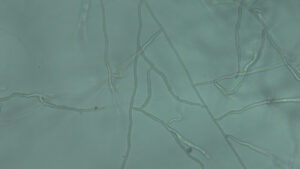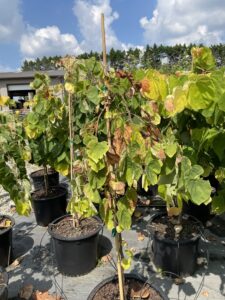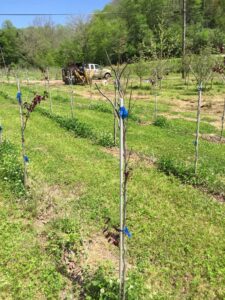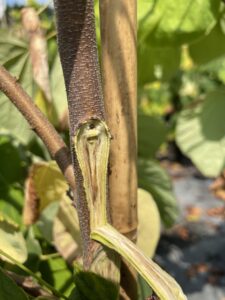The Problem
In recent years, nurseries in multiple states have reported moderate to severe dieback, chlorosis and stunting of redbud (Fig. 1). Dieback is defined as “the gradual but progressive death of individual branches or shoots from tips toward the main stem.” Dieback is a catch-all phrase that describes a constellation of symptoms that include discolored, blighted leaves, followed by wilting, flagging and branch death. Declining trees may produce water sprouts/epicormic shoots below the dead branches. This dieback may continue into the main stem or stems of the tree and ultimately cause tree death. Streaking may be observed within the water-conducting tissue (xylem) of infected branches. This issue is impacting seedlings, grafted plants, older nursery stock produced in container or field production settings and landscape plants.
Figure 1. Discolored foliage, dieback, vascular streaking and injury are a few of the symptoms observed with redbud dieback. Photos: NCSU Plant Disease and Insect Clinic
The Problem Diagnosing the Problem

Figure 2. Fungi belonging to the Rhizoctonia complex are characterized by thick hyphae that commonly grow at right angles.
Multiple laboratories throughout the country have received samples of redbud with symptoms of dieback with vascular discoloration. These laboratories have isolated a diversity of fungi; however, no known redbud pathogens have been identified to date to explain the vascular streaking symptoms. Multiple isolation attempts to check for Verticillium wilt were negative. One type of fungus that has been repeatedly isolated from symptomatic plants has been tentatively named Rhizoctonia theobromae. It belongs to the Rhizoctonia complex that includes Rhizoctonia species, but also members of Ceratobasidium, Thanatephorus, and Tulasnella. These superficially similar fungi primarily spread via thick hyphae that grow at right angles (Fig. 2). They rarely produce spores, making conclusive identification by microscope alone impossible. Fungi in this group include not only plant pathogens, but also wood-inhabiting endophytes and mycorrhizal associates. Identifying the causal agent is the first step in diagnosing what is causing this redbud dieback. Remember, these vague symptoms can be due to other plant pathogens and abiotic disorders. To determine if any of these Rhizoctonia-like fungi are causing redbud dieback, Koch’s postulates must be performed. Koch’s postulates describe a process developed in the 1880s and still used today to reliably and reproducibly confirm that the isolated microorganism is in fact the cause of the observed disease problem. Koch’s postulates provide four criteria that need to be fulfilled for an organism to be implicated in causing a specific disease. These criteria are:
- The causal agent must be consistently associated with symptomatic plants but should not be found in healthy plants.
- The causal agent must be isolated from a diseased host plant and grown in pure culture (where applicable).
- Pure culture of the causal agent incites disease when inoculated into a healthy host.
- The causal agent must again be reisolated from the inoculated, infected host and confirmed as identical to the original specific causative agent.
To date, no one has successfully completed Koch’s postulates with the fungus isolated from symptomatic redbud. This is both good and bad news: Good news, in that if this was a virulent pathogen that could spread easily from plant to plant then Koch’s postulates would have been confirmed and reported. It is bad news in that we still do not know if a single pathogen is responsible for the symptoms that are being reported in nurseries in multiple states or whether the problems may be attributed to a complex of stress factors or other biotic stressors. The fastidious nature of this fungus (hard to isolate, grow and maintain in culture) presents challenges to obtaining sufficient material for DNA analysis and for fulfilment of Koch’s postulates.
Best Management Practices with Incomplete Information
It is possible that this issue has been in the United States for some time but has been overlooked and/or misdiagnosed. This problem appears to also involve environmental factors and/or poor cultural practices, so any remediation of underlying problems will go a long way in reducing symptoms and potential infection events. Plants should be planted to the appropriate site, appropriate depth, and properly spaced. Remember, redbud is tolerant of a wide pH range but grows best where the pH is above 7.5; it cannot endure flooding or survive in poorly aerated soils. Drought stress should also be avoided. Keep in mind that redbud are also highly susceptible to phenoxy/2,4-D herbicides and other post-emergent herbicides; care should be taken whenever these are being used around young trees to avoid injury.
Excess nitrogen fertilization has been implicated in increasing plant susceptibility to several plant pathogens. Nitrogen fertility should be on the lean side, 50-100 ppm nitrate when plants are actively growing. Scouting for known pests (borers, Botryosphaeria canker, and Verticillium wilt) coupled with preventative chemical treatments are appropriate along with rigorous sanitation. Any symptomatic plants found during scouting should be sent in for diagnosis. Use only healthy, asymptomatic plants for any type of asexual propagation (chip or bud-grafting).
It is possible that this issue is associated with or exacerbated by co-infections with other soilborne pathogens such as Phytophthora spp., Pythium spp. or Fusarium spp. that are commonly found in woody ornamental nurseries. Proper management of soilborne pathogens might be beneficial in reducing the damage caused by redbud vascular streak dieback issue. At this time, there are no chemical treatments recommendations as a specific pathogen has not been identified. If using preventative fungicide drenches to protect roots against Rhizoctonia and other soilborne pathogens, they should be applied in rotation. Some recommended rotations include:
- Empress or Heritage (FRAC 11), rotated with
- Prostar (FRAC 7) or Medallion (FRAC 12) or Terraguard (FRAC 3).
OR
- Mural or Orkestra (both FRAC 7+11) rotated with
- Terraguard (FRAC 3) or Medallion (FRAC 12).
More BMP for tree and shrub production is available at: https://hort.ifas.ufl.edu/woody/documents/BMP-container-production.pdf
Special thanks to Dr. Tom Creswell, Plant and Pest Diagnostic Lab director; Dr. John Bonkowski, Plant and Pest Diagnostic Lab diagnostician; and Dr. Fulya Baysal-Gurel, Tennessee State University for their help on this article.


